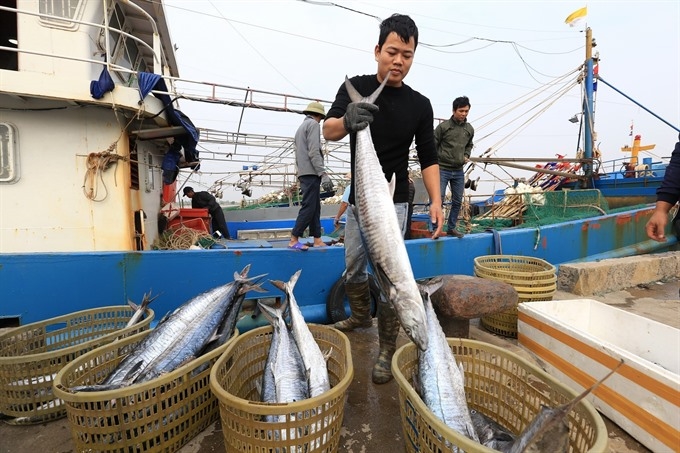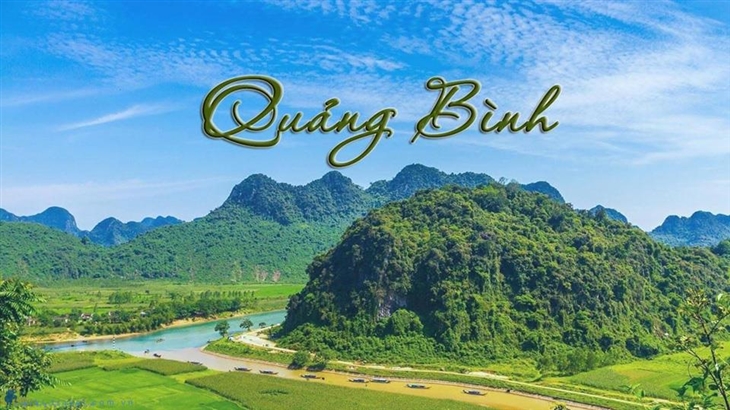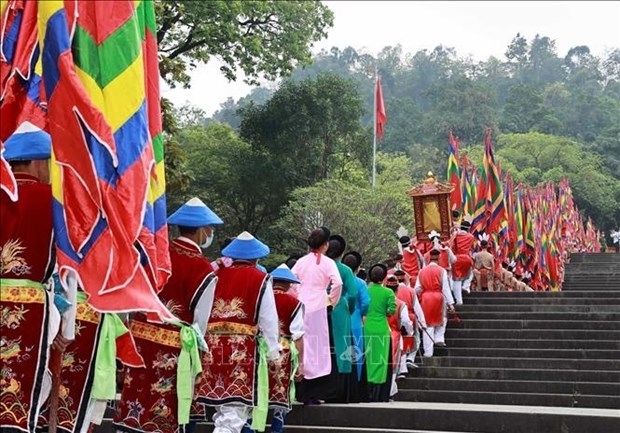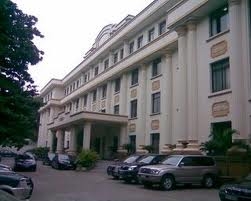Project on environmental protection in fisheries activities in a period of 2021 - 2030
Friday, September 29,2023
AsemconnectVietnam - Control and prevent pollution in aquatic activities; prevent and resolve environmental incidents; protect and develop aquatic resources and living environment, contributing to preventing biodiversity loss; improve capacity to adapt to climate change, reduce greenhouse gas emissions; Build and develop circular economy and green economic models in fisheries activities to protect environment and sustainably develop the fisheries industry
I. Objectives
1. General objectives
Control and prevent pollution in aquatic activities; prevent and resolve environmental incidents; protect and develop aquatic resources and living environment, contributing to preventing biodiversity loss; improve capacity to adapt to climate change, reduce greenhouse gas emissions; Build and develop circular economy and green economic models in fisheries activities to protect environment and sustainably develop the fisheries industry.
2. Specific goals until 2030
- Sources of pollution and waste from fisheries activities are investigated, evaluated, managed and controlled; stop the use of toxic chemicals in aquaculture that pollute water sources and reduce biodiversity;
- Aquatic natural capital sources serving socio-economic development are gradually researched, inventoried and evaluated; Build and apply natural ecosystem services and invest in developing aquatic natural capital;
- Handling environmental issues in fisheries activities; Strengthen capacity to prevent and warn of risks of environmental incidents in the fisheries industry;
- Environmental monitoring network and activities serving fisheries industry management (soil, water, and sediment monitoring) are deployed effectively; The database on aquatic environmental monitoring is built and integrated into the environmental database of the ministry and country;
- Conservation, protection and development of aquatic resources; Protecting the habitat of aquatic species, restoring important ecosystems for aquatic resources (mangroves, seagrass beds, coral reefs...) are effectively implemented, contributing to preventing decline. reduced biodiversity; Develop and promulgate at least 02 action plans to conserve, protect and regenerate a number of aquatic species prioritized for protection;
- 100% of officials, civil servants and officials of the fisheries sector; 80% of seafood enterprises; From 30 - 50% of fishermen and aquaculture households are trained/disseminated on laws, projects and plans for environmental protection in the fisheries sector;
- Contribute to improving capacity to adapt to climate change and promote mitigation of greenhouse gas emissions; maintain an annual increase of 8% in aquaculture area applying good and sustainable aquaculture practices;
- Circular economy and green economy models in the seafood value chain are researched, applied and gradually replicated.
II. Tasks and solutions
1. Mission
a) Review, develop and improve legal regulations on environmental protection in the fisheries sector
- Coordinate with the Ministry of Natural Resources and Environment and the Ministry of Science and Technology to review, research and propose the development/amendment of legal documents related to environmental protection in the fisheries sector to ensure specialized characteristics;
- Develop and promulgate regulations and technical instructions on proactively preventing and controlling waste sources in fisheries activities with high risk of environmental pollution, amending and supplementing the system of standards and regulations. National technical standards on environmental protection in the fisheries sector;
- Develop and implement environmental management plans in fisheries activities;
- Develop regulations to achieve the goal of collecting and minimizing waste from aquatic production activities; especially for small-scale exploitation, farming, processing and business establishments/households.
b) Proactively prevent, manage and control sources of pollution and waste from fisheries activities; Environmental monitoring for fisheries industry management (soil, water, sediment monitoring)
- Investigate and evaluate overall waste sources in aquatic activities (fishery exploitation, aquaculture, seafood processing, fishery infrastructure systems);
- Develop and promulgate environmental management plans and implement solutions to control waste from fisheries activities; Focus on controlling and preventing pollution in coastal areas and areas with high biodiversity value;
- Be proactive in solving environmental issues and problems arising in fisheries activities;
- Review, consolidate and build an environmental monitoring network (soil, water, sediment); Carry out annual environmental monitoring (soil, water, sediment) in concentrated/key farming areas, fishing port systems, input and output water supplies for aquaculture areas, and craft villages seafood processing, marine conservation areas and aquatic resource protection areas; Implement the Plan for environmental monitoring, warning and supervision in aquaculture for the period 2021 - 2025 (Decision No. 1151/QD-BNN-TCTS dated March 19, 2021 of the Ministry of Agriculture and Rural Development ); Organize training and capacity building on environmental monitoring for civil servants, public employees, and local workers;
- The database on aquatic environmental monitoring is built and integrated into the environmental database of the ministry and country;
- Investigate, evaluate and classify the environmental quality of fallow aquaculture areas; Develop and implement plans to renovate and restore polluted areas due to impacts from aquaculture activities;
- Implement the Plan to manage ocean plastic waste in the fisheries sector for the period 2021 - 2030 (Decision No. 687/QD-BNN-TCTS dated February 5, 2021 of the Ministry of Agriculture and Rural Development);
- Implement regulations in Annex V of the International Convention for the Prevention of Pollution from Ships;
- Strengthen inspection and supervision of environmental protection in fisheries activities.
c) Inventory and evaluate aquatic natural capital sources to serve sustainable development of the fisheries industry
- Investigate, evaluate, and inventory aquatic natural capital (tangible value, intangible value... of aquatic resources, aquatic habitat, aquatic waste systems...) ;
- Research and develop policies and mechanisms to effectively use aquatic natural resources;
- Research and develop mechanisms for policies on payments for ecosystem services to create resources to ensure sustainable use of natural capital (tangible, intangible values...);
- Research, develop and apply the voluntary extended responsibility mechanism of manufacturers and importers related to the seafood sector;
- Effectively deploy the Fishery Resources Protection and Development Fund.
d) Guide, inspect, and build capacity to prevent and warn of risks of environmental incidents in the fisheries industry
- Models for preventing, controlling, and warning about the risk of environmental incidents are researched, developed, and gradually applied in the fields of aquaculture, seafood exploitation, seafood processing, and infrastructure. fisheries facilities; plans to prevent, control, and warn of risks of environmental incidents in fisheries activities are developed; Technical guidelines are developed and applied nationwide;
- Improve capacity and skills to prevent and warn of risks of environmental incidents for relevant parties;
- Participate in responding to environmental incidents within the scope of management as assigned by the National Committee for Incident and Disaster Response and Search and Rescue.
d) Promote circular economy and green economic models in fisheries activities
- Apply science and technology and technical advances to ensure effective use of natural aquatic resources and minimize environmental pollution in aquatic activities;
- Transform the fisheries model towards a circular economy and green economy; Developing organic, high-tech, environmentally friendly seafood production, implementing the National Action Program on sustainable production and consumption for the period 2021 - 2030 issued with Decision No. 889/ Decision-TTg dated June 24, 2020 of the Prime Minister;
- Research, build and gradually apply models of enterprises/establishments/craft village clusters/cooperative groups for aquaculture, processing, exploitation and trading of aquatic products towards green production, using raw materials. Environmentally friendly materials;
- Apply production models that adapt to climate change based on ecosystems;
- Develop documents to guide, train, and support the implementation and replication of models for developing sustainable seafood processing linkages/craft village clusters, models for sustainable product supply chains, and sustainable product supply chains. supply associated with product traceability; organic seafood production model, ensuring connection with the national product and goods traceability information portal.
e) Conserve, protect and develop aquatic resources, restore important ecosystems, contributing to preventing biodiversity loss
- Protect the living environment (environmental quality, typical ecosystems: coral reefs, seagrass beds, mangrove forests...) of aquatic species;
- Expand the system of marine protected areas; zoning, recognition and management of aquatic resource protection zones;
- Research and develop other effective area-based conservation measures (OECM) to create incentives for conservation outside protected areas;
- Develop and implement a project to restore core ecosystems for aquatic resources: coral reefs, seagrass beds, mangrove forests, estuarine, coastal and sea areas identified as beaches. spawning, nursing, breeding areas for endangered and rare aquatic species, economically valuable species, endemic and indigenous species;
- Develop programs/action plans to conserve, protect and develop endangered and rare aquatic species and species that need to be prioritized for protection to meet the requirements of export markets;
- Develop and implement plans to conserve and store endangered, rare, endemic and indigenous aquatic genetic resources; promote access to genetic resources and benefit sharing; build a database on aquatic genetic resources;
- Strengthen the prevention of illegal, unreported and unregulated fishing;
- Strictly control and prevent invasive alien aquatic species.
2. Solution
a) Raise awareness and thinking about environmental protection in fisheries activities for relevant parties
- Disseminate and raise awareness at all levels and sectors about the view that "the environment is a condition, foundation, and prerequisite for sustainable economic and social development" according to Conclusion No. 56- KL/TW dated August 23, 2019 of the Politburo on continuing to implement Resolution 7 of the 7th Central Committee, Session XI on proactively responding to climate change, strengthening resource management and environmental protection. Gradually change the awareness and thinking of all levels and sectors in development policy planning;
- Raise awareness and understanding of green economy and circular economy; Encourage businesses and seafood production/business households to implement voluntary environmental standards and commitments; awareness of compliance with the law and good implementation of environmental social responsibilities of seafood production enterprises and fishing communities;
- Communicate about environmental protection in fisheries activities in particular and environmental protection in general to relevant parties, especially focusing on the fishing community, aquaculture farmers, and seafood processors. and residential communities participating in fisheries activities.
b) Developing science and applying technology in fisheries activities and waste treatment from fisheries activities
- Scientific research, technology application, technical advances in aquaculture activities in the direction of modern, environmentally friendly advanced technology, minimizing waste according to a circular economy;
- Socialize and encourage businesses to participate in research and application of technology in waste treatment from fisheries activities; socialize and improve the capacity of the system of organizations evaluating environmental conformity;
- Build an aquatic environmental database that is interconnected with the national aquatic database system; The database is updated regularly and promptly. Step by step digitally convert the aquatic environment database;
- Applying 4.0 technology, information technology, remote sensing, AI, traceability... in monitoring, inspecting and supervising production, business and environmental treatment processes.
c) Invest in infrastructure construction to ensure the treatment, collection, storage and transportation of waste; aquatic environmental monitoring network
- Invest in synchronous infrastructure development in concentrated aquaculture areas, key aquaculture areas, fishing port systems, storm shelters, seafood processing villages... to ensure ensure regulations on environmental protection;
- Develop a synchronous network of aquatic environmental monitoring from central to local levels; Develop and implement an effective aquatic environmental monitoring program (aquaculture, fisheries exploitation, seafood processing, fisheries infrastructure);
- Invest in infrastructure and synchronous equipment for marine protected areas to effectively conserve, protect and develop sustainable aquatic resources.
d) Research mechanisms and policies to encourage exploitation, use of investment, and maintain and develop aquatic natural capital resources; Mobilize and socialize resources in protecting the aquatic environment
- Develop policies, laws, national standards, national technical regulations, and technical instructions on environmental protection in fisheries activities;
- Research and develop a mechanism to pay for aquatic ecosystem services to create a sustainable financial source for the protection, maintenance and development of aquatic ecosystems; mechanisms, policies, incentives, and support for environmentally friendly fisheries activities;
- Develop a mechanism to encourage businesses to participate in providing environmental services in recycling, waste treatment, and environmental pollution treatment in the fisheries sector;
- Promoting the role of the Fund for the Protection and Development of Aquatic Resources; Encourage and support the formation of Provincial Funds and Community Funds to create capital for environmental protection in the fisheries sector;
- Encourage and support the formation of public-private partnerships (PPP) in environmental protection in the fisheries sector;
- Research, develop and promulgate a mechanism for voluntary expanded responsibility of businesses in protecting the aquatic environment;
- Research, build and replicate circular economy and green economy models in seafood production.
e) Strengthen the implementation of policies and laws on environmental protection in fisheries activities
- Review and overcome overlaps and inadequacies in functions and tasks of state management of the environment among ministries and branches; Implement decentralization between central and local levels to ensure consistency and continuity in state management of environmental protection;
- Implement regulations on environmental protection according to international commitments that Vietnam has participated in;
- Carry out inspection and supervision of local management responsibilities for environmental protection;
- Strengthen community supervision of aquatic environmental protection; Transparency of environmental information and environmental protection through the application of information technology.
f) International cooperation on environmental protection
- Enforce environmental regulations and commitments in free trade agreements, especially new generation free trade agreements to ensure sustainable development of the fisheries industry;
- Cooperate closely with neighboring countries and countries in the ASEAN region on cross-border environmental issues: aquatic resources, ocean plastic waste, endangered and rare species, environmental pollution marine school...;
- Strengthen multilateral cooperation: promote the implementation of commitments on environmental protection, biodiversity, sustainable use of natural resources, and attract technical assistance projects.
III. Priority projects and tasks
- Communicate and raise awareness and thinking about environmental protection in fisheries activities;
- Investigate, evaluate the current situation and propose and develop preferential policies and mechanisms to support environmentally friendly fisheries activities to promote circular economy and green economy;
- Program to investigate, evaluate, and inventory aquatic natural capital (tangible value, intangible value...) to serve socio-economic development;
- Investigate and evaluate pollution sources and waste amounts from fisheries activities and propose management solutions;
- Strengthen capacity to prevent and warn of risks of environmental incidents in the fisheries industry;
- Environmental monitoring for fisheries industry management (soil, water, and sediment monitoring);
- Investigate and evaluate the current state of technology, apply technology in waste treatment in aquaculture, seafood exploitation, seafood processing and propose technological solutions for waste treatment in operations. Seafood;
- Innovating and applying waste treatment technology in fisheries activities creates a premise for utilizing waste products and aquatic by-products in the form of public-private cooperation;
- Research and gradually invest in building an advanced waste management model in fisheries activities;
- Build, update and operate the fisheries industry environmental database.
IV. Implementation organization
1. Ministry of Agriculture and Rural Development
a) Chair and coordinate with ministries, branches, People's Committees of provinces and cities and relevant agencies to organize the implementation of the Project; develop an environmental management plan and control waste from fisheries activities; proactively integrate the goals and tasks of the Project with national target programs and related projects implemented by the Ministry of Agriculture and Rural Development.
b) Organize guidance, supervision, urging, inspection, preliminary assessment of annual, 5-year and 10-year performance results; promptly propose and submit recommendations to the Prime Minister to decide on arising issues that exceed authority, adjust the Project, supplement priority projects and tasks in accordance with practical conditions.
c) Organize activities to raise awareness and thinking about environmental protection in seafood production; Strengthen the implementation of policies and laws on environmental protection in fisheries activities.
d) Research mechanisms and policies to encourage exploitation, use, investment, and maintenance of development of aquatic natural capital resources; Mobilize and socialize resources in protecting the aquatic environment.
e) Preside and coordinate with ministries and branches to review and supplement policies specific to the aquatic environment to promote circular economy and green economic models in fisheries activities. Build an aquatic environmental database ready to connect to the national database system.
f) Develop and implement priority projects and tasks under this Project.
g) Coordinate with the Ministry of Finance to synthesize and submit to competent authorities to balance and allocate state budget funds for the Ministry of Agriculture and Rural Development to implement the Project and priority projects according to regulations of the Ministry of Agriculture and Rural Development. State Budget Law and guiding documents; balance and allocate capital to carry out tasks in the Project on schedule after being allocated by competent authorities.
2. Ministry of Natural Resources and Environment
a) Take charge and coordinate with the Ministry of Agriculture and Rural Development to ensure that the proportion of hazardous solid waste arising from production, business, import and export activities of seafood is collected, transported and treated. meets environmental protection requirements.
b) Preside and coordinate with the Ministry of Agriculture and Rural Development to develop national technical regulations on waste for seafood processing facilities and aquaculture facilities in accordance with the specific characteristics industry, ensuring sustainable development.
c) Preside and coordinate with the Ministry of Agriculture and Rural Development to develop programs and effectively deploy measures to prevent, control and prevent invasive alien aquatic species; Strengthen biosafety management for genetically modified organisms.
3. Ministry of Science and Technology
a) Preside and coordinate with relevant ministries and agencies to strengthen policies to support investment, research, application and transfer of high technology and environmentally friendly technology in fisheries activities to increase productivity. productivity, production efficiency and environmental friendliness.
b) Coordinate with the Ministry of Agriculture and Rural Development and relevant ministries and branches to develop and announce national standards, prioritizing harmonization with international standards and regional standards; appraisal of national technical regulations; Deploy solutions on conformity assessment and apply traceability according to the perspective and goals of the Project;
c) Strengthen support for intellectual property protection, know-how and technological solutions in green production fields of aquatic products and in the field of aquatic environmental protection.
4. Ministry of Finance
a) Preside and guide the management, use and settlement of public funds to implement the Project.
b) Preside and coordinate with the Ministry of Agriculture and Rural Development to synthesize and submit to competent authorities to balance and allocate state budget funds to the Ministry of Agriculture and Rural Development and other ministries and branches. to implement the Project and priority projects according to the provisions of the State Budget Law and guiding documents. Based on the balance ability of the central budget, on the basis of proposals of the Ministry of Agriculture and Rural Development and relevant ministries and branches, prioritize the synthesis and arrangement in the annual regular expenditure estimates of the bank. central policy, submit to competent authorities for consideration and decision to balance and allocate funds in expenditure estimates of agencies and units according to the provisions of the State Budget Law and guiding documents for implementation. Scheme".
5. Ministry of Public Security
Strengthen inspection, control and handling of environmental protection violations in the fisheries sector.
6. Other relevant ministries and branches
a) Relevant ministries and branches, according to their functions and tasks, are responsible for presiding and coordinating with the Ministry of Agriculture and Rural Development to effectively deploy the contents and tasks of the Project.
b) Allocate funds from the central budget expenditure estimates assigned by competent authorities and other legal funding sources to organize the implementation of assigned tasks according to the provisions of law.
7. People's Committees of provinces and centrally run cities
a) Based on the local practical situation, direct the implementation of the Project; promulgate policies to encourage and support businesses, households, and fishing communities; Focus on policy mechanisms to promote aquatic activities towards green, clean, circular economy, suitable for local resources.
b) Organize land use planning for environmental treatment from aquatic activities in concentrated aquaculture areas, fishing ports, and industrial clusters of seafood processing villages.
c) Organize or coordinate with state management agencies to effectively deploy support policies for people, cooperatives, and businesses participating in fisheries activities, processing, and recycling waste from fisheries activities.
Source: thuvienphapluat.vn
National target program on building new countryside in a period of 2021 - 2025
Supporting industry development project in Binh Phuoc province for a period of 2021-2025, orientation to 2030
Project of developing construction materials in Binh Dinh province in a period of 2021 - 2030, vision to 2050
Project of developing construction material industry in the province in a period of 2021-2025 with orientation to 2030
Implementation plan of labor market supporting development program until 2030 in Bac Lieu province
Implementation plan of project of "Ensuring food safety, improving quality of agriculture, forestry and fishery in a period of 2021 - 2030" in Can Tho city
Project on sustainable livestock development in a period of 2021 - 2025 and orientation to 2030 in Kien Giang province
Implementation plan of national action program on sustainable production and consumption in 2023 in Ca Mau Province
Implementation plan of sustainable forestry development program in a period of 2021 - 2025 in Binh Thuan province
Plan on implementing national environmental protection strategy to 2030 with a vision to 2050 in Binh Thuan province
Approving master plan of Ha Tinh province in a period of 2021 – 2030 with a vision to 2050
Plan on implementing Decision No.858/QD-TTG dated July 20, 2022 of the Prime Minister approving strategy for development of agriculture and agro-forestry-fishery mechanization processing by 2030 in Tuyen Quang province
Plan on implementing strategy of science, technology and innovation development in Yen Bai province to 2030
Implementation plan for Decision No.1129/QD-TTg dated July 27, 2020 of Prime Minister approving project of developing night economy in Vietnam in Gia Lai province

Plan on implementing national strategy on climate change ...
Actively and effectively adapting, reducing vulnerability, loss and damage due to climate change; reduce greenhouse gas emissions ...Scheme on attracting, restructuring and improving quality ...
Urban development plan of Binh Phuoc province in a period ...
Plan on implementing Decision No. 327/QD-TTG dated March ...

Hung Kings Temple Festival 2023 kicks off
The Hung Kings Temple Festival 2023 and the Culture and Tourism Week of Ancestral Land 2023 kicked off in the northern province of Phu Tho ...Vietnam trounce Palestine at AFC U-17 Women's Asian ...
Phu Tho: Festival honours UNESCO intangible cultural ...
Saigontourist Group Food and Culture Festival 2023 opens
Vietnam’s top swimmer Huy Hoang to hold Vietnamese flag at ...



